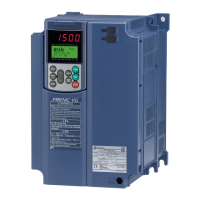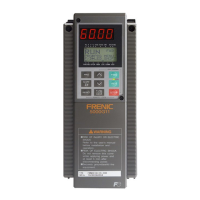5-110
F codes
E codes
C codes
P codes
H codes
A codes
b codes
r codes
J codes
d codes
U codes
y codes
Chap. 5 FUNCTION CODES
In addition, during deceleration triggered by turning the run command OFF, the anti-regenerative control increases the
output frequency so that the inverter may not stop the load depending on the load state (huge moment of inertia, for
example). To avoid that, H69 provides a choice of cancellation of the anti-regenerative control to apply when three
times the specified deceleration time is elapsed, thus decelerating the motor forcibly.
Function
Data for H69
Control mode
Force-to-stop with actual deceleration time exceeding
three times the specified one
0 Disable automatic deceleration ―
2 Torque limit control Enable
3 DC link bus voltage control Enable
4 Torque limit control Disable
5 DC link bus voltage control Disable
Torque Limiter (Frequency increment limit for braking) (H76) Data setting range: 0.0 to 500.0 (Hz)
Since increasing the output frequency too much in the torque limit control mode is dangerous, the inverter has a torque
limiter (Frequency increment limit for braking) that can be specified by H76. The torque limiter limits the inverter's
output frequency to less than "Reference frequency + H76 setting."
Note that the torque limiter activated restrains the anti-regenerative control, resulting in a trip with an overvoltage alarm
in some cases. Increasing the H76 data makes the anti-regenerative control capability high.
• Enabling the automatic deceleration (anti-regenerative control) may automatically increase the deceleratio
time.
• When a braking unit is connected, disable the anti-regenerative control. The automatic deceleration control
may be activated at the same time when a braking unit starts operation, which may make the deceleration
time fluctuate.
• If the set deceleration time is too short, the DC link bus voltage of the inverter rises quickly, an
consequently, the automatic deceleration may not follow the voltage rise. In such a case, specify a longe
deceleration time.
H70 Overload Prevention Control
H70 specifies the decelerating rate of the output frequency to prevent a trip from occurring due to an overload. This
control decreases the output frequency of the inverter before the inverter trips due to a heat sink overheat or inverter
overload (with an alarm indication of
0h1
or
0lu
, respectively). It is useful for equipment such as pumps where a
decrease in the output frequency leads to a decrease in the load and it is necessary to keep the motor running even when
the output frequency drops.
Data for H70 Function
0.00 Decelerate the motor by deceleration time 1 (F08) or 2 (E11)
0.01 to 100.0 Decelerate the motor by deceleration rate from 0.01 to 100.0 (Hz/s)
999 Disable overload prevention control
Overload prevention control -- OLP (E20 to E24 and E27, data = 36)
This output signal comes ON when the overload prevention control is activated and the output frequency changed.
(Minimum width of the output signal: 100 ms)
In equipment where a decrease in the output frequency does not lead to a decrease in the load, the overload
prevention control is of no use and should not be enabled.
H71 Deceleration Characteristics
Setting the H71 data to "1" enables forced brake control. If regenerative energy produced during the deceleration of the
motor and returned to the inverter exceeds the inverter’s braking capability, an overvoltage trip will occur. The forced
brake control increases the motor energy loss during deceleration, increasing the deceleration torque.
Data for H71 Function
0 Disable
1 Enable
This function is aimed at controlling the torque during deceleration; it has no effect if there is a braking load.
Enabling the automatic deceleration (anti-regenerative control, H69 = 2 or 4) in the torque limit control mode
disables the deceleration characteristics specified by H71.
CTi Automation - Phone: 800.894.0412 - Fax: 208.368.0415 - Web: www.ctiautomation.net - Email: info@ctiautomation.net

